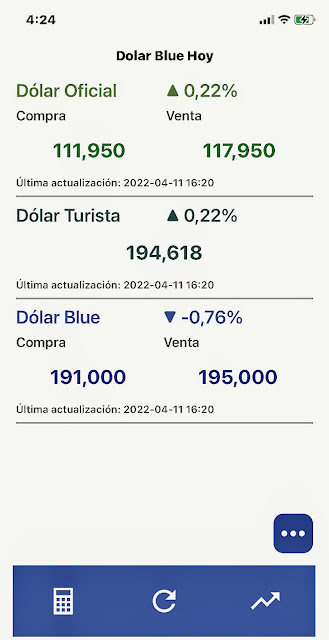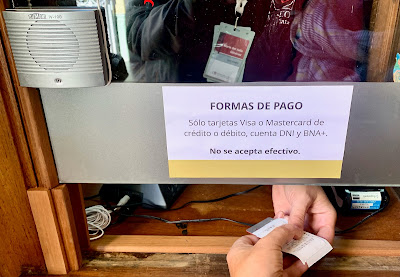What is a cueva? In Spanish it’s literally a cave and some of them, like the Cueva de las Manos in southern Argentine Patagonia, are major archaeological sites and tourist attractions. But there are caves of a different sort in Buenos Aires and other Argentine cities, and any savvy traveler will get to know them because they are places to change money at an advantageous rate—unlike the traditional casa de cambio (exchange house).
 |
| A traditional exchange house in the Patagonian city of San Carlos de Bariloche |
 |
| When I last visited the coastal Patagonia city of Puerto Madryn, this auto glass dealer gave the best rates for US dollars. |
That’s because banks and exchange houses can only change at the official legal rate, which is barely more than half the informal but nevertheless tolerated “blue dollar” rate. In present-day Argentina, using your credit card or withdrawing cash from an ATM means, in effect, doubling the price of everything you may purchase. For the latest rates, there’s a smartphone app called “Dólar Blue Hoy,” which is available on both the App Store and Google Play.
 |
| Today's rates on the Dólar Blue app |
Walking down Calle Florida, the downtown pedestrian street that’s traditionally the city’s retail hub, you’ll hear a constant chorus of “cambio, cambio” from arbolitos (street changers, known as “little trees” because they’re planted on the sidewalk). In the 1980s, when hyper-inflation was rife here, we used to change travelers’ checks (remember those?) at desks in otherwise vacant office buildings and, though we never got cheated, we never felt really comfortable with it. Today we trust our neighborhood cuevas in Palermo, but might make inquiries before visiting one in another part of the city.
 |
| Bring big Bens to the cueva. |
 |
| At present, Argentina's largest banknote is 1000 pesos (about US$5). |
While you may arrive here with a money belt packed with Ben Franklins, you’ll need wallet space for many more bills in a country whose largest denomination is presently 1000 pesos (roughly US$5). Be aware that, at most cuevas, hundreds are the notes of choice (though fifties are usually acceptable), and they’ll have to be in mint condition. Twenties are often unwelcome, but today the Western Union branch down the block from us changed $100 worth at just a slightly lower rate.
 |
| The closest cueva to our apartment is this Western Union office (your mileage may vary). |
 |
| Your blue dollars can't buy one of our sofas. |
In a few places, your blue dollar is not welcome, as this sign outside a furniture outlet in the Retiro neighborhood suggests (of course, one could change money elsewhere before making a purchase). Recently, when we visited the exceptional Museo de La Plata in Buenos Aires Province, we found it did not accept cash and we had to pay the admission fee by credit card at the official rate (given that the fee was just AR$300 per person, this was hardly a budget breaker).
 |
| Your cash is no good at the Museo de La Plata. |
That’s the current scenario, but how long will it last? By November, when the next tourist season rolls around, and given the uncertainties of war in Europe and the lingering pandemic, it’s hard to speculate. One recent report suggests that the breech between the official and informal exchange may diminish over the next year-plus, but there has also speculation about dollarization of the Argentine economy. That’s something that failed in the 1990s under former President Carlos Menem and it’s certainly not gonna happen under current Peronist President Alberto Fernández. Elections are due to take place in October of 2023, though.
Post-Mortem Update
Since I first published this entry, I have learned that Buenos Aire's iconic Cementerio de la Recoleta has just instituted an admission charge of AR$1400 for foreign visitors, though it remains free of charge for Argentines. Like the Museo de La Plata (cited above), they do not accept cash, so it will now cost roughly US$12.50 at the official exchange rate. Visitors can pay online in advance or via QR code or credit card at the main gate.

No comments:
Post a Comment